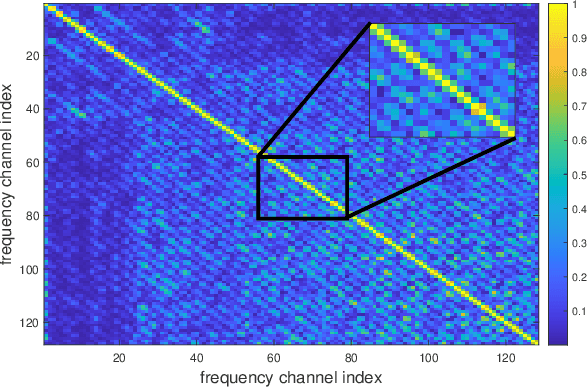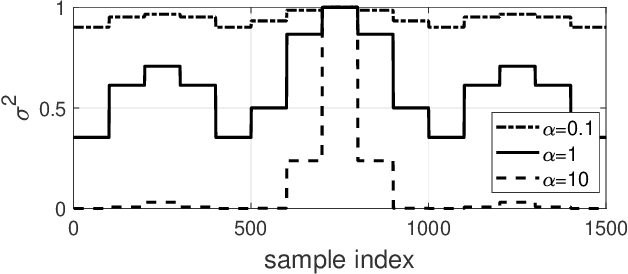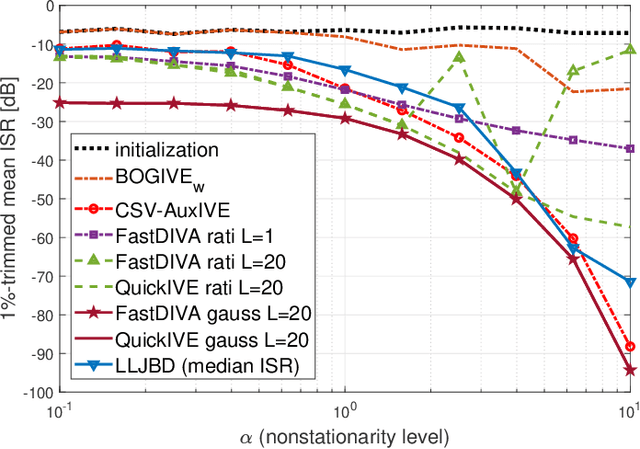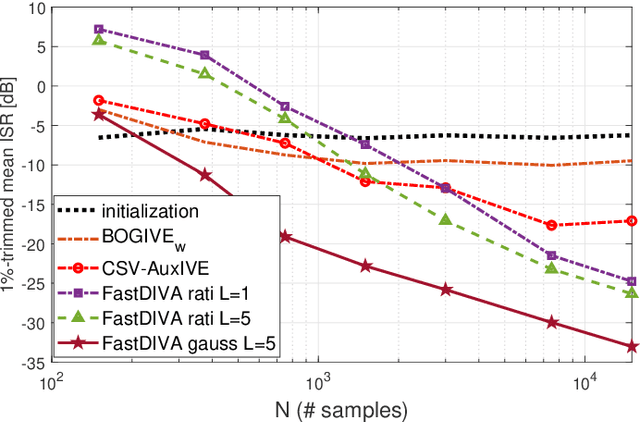Zbyněk Koldovský
Blind Capon Beamformer Based on Independent Component Extraction: Single-Parameter Algorithm,
Feb 06, 2025

Abstract:We consider a phase-shift mixing model for linear sensor arrays in the context of blind source extraction. We derive a blind Capon beamformer that seeks the direction where the output is independent of the other signals in the mixture. The algorithm is based on Independent Component Extraction and imposes an orthogonal constraint, thanks to which it optimizes only one real-valued parameter related to the angle of arrival. The Cram\'er-Rao lower bound for the mean interference-to-signal ratio is derived. The algorithm and the bound are compared with conventional blind and direction-of-arrival estimation+beamforming methods, showing improvements in terms of extraction accuracy. An application is demonstrated in frequency-domain speaker extraction in a low-reverberation room.
Informed FastICA: Semi-Blind Minimum Variance Distortionless Beamformer
Jul 12, 2024Abstract:Non-Gaussianity-based Independent Vector Extraction leads to the famous one-unit FastICA/FastIVA algorithm when the likelihood function is optimized using an approximate Newton-Raphson algorithm under the orthogonality constraint. In this paper, we replace the constraint with the analytic form of the minimum variance distortionless beamformer (MVDR), by which a semi-blind variant of FastICA/FastIVA is obtained. The side information here is provided by a weighted covariance matrix replacing the noise covariance matrix, the estimation of which is a frequent goal of neural beamformers. The algorithm thus provides an intuitive connection between model-based blind extraction and learning-based extraction. The algorithm is tested in simulations and speaker ID-guided speaker extraction, showing fast convergence and promising performance.
Comparison of Frequency-Fusion Mechanisms for Binaural Direction-of-Arrival Estimation for Multiple Speakers
Jan 15, 2024Abstract:To estimate the direction of arrival (DOA) of multiple speakers with methods that use prototype transfer functions, frequency-dependent spatial spectra (SPS) are usually constructed. To make the DOA estimation robust, SPS from different frequencies can be combined. According to how the SPS are combined, frequency fusion mechanisms are categorized into narrowband, broadband, or speaker-grouped, where the latter mechanism requires a speaker-wise grouping of frequencies. For a binaural hearing aid setup, in this paper we propose an interaural time difference (ITD)-based speaker-grouped frequency fusion mechanism. By exploiting the DOA dependence of ITDs, frequencies can be grouped according to a common ITD and be used for DOA estimation of the respective speaker. We apply the proposed ITD-based speaker-grouped frequency fusion mechanism for different DOA estimation methods, namely the multiple signal classification, steered response power and a recently published method based on relative transfer function (RTF) vectors. In our experiments, we compare DOA estimation with different fusion mechanisms. For all considered DOA estimation methods, the proposed ITD-based speaker-grouped frequency fusion mechanism results in a higher DOA estimation accuracy compared with the narrowband and broadband fusion mechanisms.
Independent Vector Extraction Constrained on Manifold of Half-Length Filters
Apr 04, 2023Abstract:Independent Vector Analysis (IVA) is a popular extension of Independent Component Analysis (ICA) for joint separation of a set of instantaneous linear mixtures, with a direct application in frequency-domain speaker separation or extraction. The mixtures are parameterized by mixing matrices, one matrix per mixture. This means that the IVA mixing model does not account for any relationships between parameters across the mixtures/frequencies. The separation proceeds jointly only through the source model, where statistical dependencies of sources across the mixtures are taken into account. In this paper, we propose a mixing model for joint blind source extraction where the mixing model parameters are linked across the frequencies. This is achieved by constraining the set of feasible parameters to the manifold of half-length separating filters, which has a clear interpretation and application in frequency-domain speaker extraction.
Dynamic Independent Component Extraction with Blending Mixing Vector: Lower Bound on Mean Interference-to-Signal Ratio
Dec 02, 2022
Abstract:This paper deals with dynamic Blind Source Extraction (BSE) from where the mixing parameters characterizing the position of a source of interest (SOI) are allowed to vary over time. We present a new source extraction model called CvxCSV which is a parameter-reduced modification of the recent Constant Separation Vector (CSV) mixing model. In CvxCSV, the mixing vector evolves as a convex combination of its initial and final values. We derive a lower bound on the achievable mean interference-to-signal ratio (ISR) based on the Cram\'er-Rao theory. The bound reveals advantageous properties of CvxCSV compared with CSV and compared with a sequential BSE based on independent component extraction (ICE). In particular, the achievable ISR by CvxCSV is lower than that by the previous approaches. Moreover, the model requires significantly weaker conditions for identifiability, even when the SOI is Gaussian.
Joint Acoustic Echo Cancellation and Blind Source Extraction based on Independent Vector Extraction
May 13, 2022
Abstract:We describe a joint acoustic echo cancellation (AEC) and blind source extraction (BSE) approach for multi-microphone acoustic frontends. The proposed algorithm blindly estimates AEC and beamforming filters by maximizing the statistical independence of a non-Gaussian source of interest and a stationary Gaussian background modeling interfering signals and residual echo. Double talk-robust and fast-converging parameter updates are derived from a global maximum-likelihood objective function resulting in a computationally efficient Newton-type update rule. Evaluation with simulated acoustic data confirms the benefit of the proposed joint AEC and beamforming filter estimation in comparison to updating both filters individually.
Double Nonstationarity: Blind Extraction of Independent Nonstationary Vector/Component from Nonstationary Mixtures -- Algorithms
Apr 11, 2022



Abstract:In this article, nonstationary mixing and source models are combined for developing new fast and accurate algorithms for Independent Component or Vector Extraction (ICE/IVE), one of which stands for a new extension of the well-known FastICA. This model allows for a moving source-of-interest (SOI) whose distribution on short intervals can be (non-)circular (non-)Gaussian. A particular Gaussian source model assuming tridiagonal covariance matrix structures is proposed. It is shown to be beneficial in the frequency-domain speaker extraction problem. The algorithms are verified in simulations. In comparison to the state-of-the-art algorithms, they show superior performance in terms of convergence speed and extraction accuracy.
 Add to Chrome
Add to Chrome Add to Firefox
Add to Firefox Add to Edge
Add to Edge